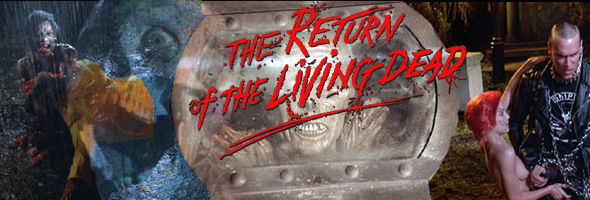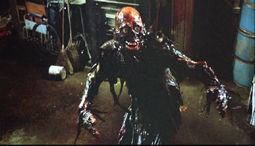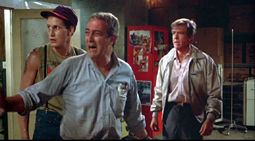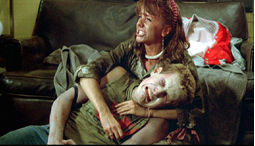
Color, 1985, 91m. / Directed by Dan O'Bannon / Starring Clu Gulager, James Karen, Don Calfa, Thom Matthews, Linnea Quigley / MGM (US R1 NTSC) / WS (1.85:1) (16:9), Tartan (UK R0 PAL)
The legal fallout over 1968's horror classic Night of the Living Dead still lingers today, as divergent sequels, sequels, and other cinematic riffs involving George A. Romero, Tom Savini, John Russo, and a host of others continue to pop up every few years. These can range from worthy (Dawn of the Dead
The legendary opening sequence introduces two dimwitted medical supply employees, Frank (James Karen) and Freddy (Thom Matthews).
Usually classified as a comedy, Return of the Living Dead does contain some wonderfully witty moments (including an unforgettable diagnosis scene involving two major characters) but is, above all, a horror movie through and through. This is not a campy spoof; it treats its subject with reverence and plays fair with the viewer, never condescending and always trying to deliver as many thrills as possible. The result is one of the best horror films of the 1980s, up there with the likes of Re-Animator, Near Dark, The Stepfather, and A Nightmare on Elm Street. Gulager and Karen deservedly earned a lot of genre work after this, but the entire cast nails their roles perfectly with a tricky script which balances a wide variety of tonal shifts. There's also an impeccably chosen punk score (featuring The Cramps, of course) and an unforgettable shocker of an ending that would never, ever fly with today's audiences.
 and Savini's remake) to insulting (Children of the Living Dead), but horror fans had an especially weird situation in 1985 when no less than two sequels-of-sorts appeared on movie screens. Though hobbled by production cutbacks, Romero's Day of the Dead was a haunting and grueling conclusion to his dead trilogy that brought his beloved zombies in the 1980s with great panache. Meanwhile, Russo and Russ Streiner teamed up with Romero pal Rudy Ricci for a half-funny, half-scary sequel which ignored Dawn entirely. Alien and Dead and Buried scribe Dan O'Bannon was brought in for screenwriting and directing chores, and fortunately he proved to be just the right man for the job. The resulting film took nearly everyone by surprise and became an instant cult classic, propelling naked punker Linnea Quigley to scream queen status and kicking off another line of sequels on its own.
and Savini's remake) to insulting (Children of the Living Dead), but horror fans had an especially weird situation in 1985 when no less than two sequels-of-sorts appeared on movie screens. Though hobbled by production cutbacks, Romero's Day of the Dead was a haunting and grueling conclusion to his dead trilogy that brought his beloved zombies in the 1980s with great panache. Meanwhile, Russo and Russ Streiner teamed up with Romero pal Rudy Ricci for a half-funny, half-scary sequel which ignored Dawn entirely. Alien and Dead and Buried scribe Dan O'Bannon was brought in for screenwriting and directing chores, and fortunately he proved to be just the right man for the job. The resulting film took nearly everyone by surprise and became an instant cult classic, propelling naked punker Linnea Quigley to scream queen status and kicking off another line of sequels on its own.
 The former tells an elaborate story claiming that Night of the Living Dead was actually a bastardized version of a true story, and the real zombies are now stored in the supply warehouse in which both men work. Of course a cannister containing one of them is accidentally opened, sending contaminated incineration fumes into the air over a nearby graveyard. A medical corpse promptly comes to life, wreaking havoc on the two numbskulls before finally being dispatched... well, as the characters point out, it doesn't happen like it did in the movie. The company owner (Clu Gulager) and a carload of punks are drawn into the action as well when the dead begin to rise from their graves, loudly demanding "Brains!"
The former tells an elaborate story claiming that Night of the Living Dead was actually a bastardized version of a true story, and the real zombies are now stored in the supply warehouse in which both men work. Of course a cannister containing one of them is accidentally opened, sending contaminated incineration fumes into the air over a nearby graveyard. A medical corpse promptly comes to life, wreaking havoc on the two numbskulls before finally being dispatched... well, as the characters point out, it doesn't happen like it did in the movie. The company owner (Clu Gulager) and a carload of punks are drawn into the action as well when the dead begin to rise from their graves, loudly demanding "Brains!"
 Endless rights entanglements have resulted in Return of the Living Dead going in and out of availability to a frustrating degree. Originally shot open matte, the first 1.33:1 transfer shown on cable and available on video from HBO has long been the most widely seen, ported over eventually to a mediocre, extras-free DVD release in the UK from Tartan. (Ironically, a matted laserdisc was released as well, only in the UK.) MGM's US DVD offers a more generous package, beginning with the option of either open matte or 1.85:1 letterboxed presentations. Both look quite nice, improving dramatically over their predecessors with nicely balanced color schemes which frequently erupt in surprising splashes of sickly green and blue. The anamorphic widescreen edition loses a hefty amount of interesting visual details from the top and bottom but offers marginally increased clarity on 16:9 displays, so judge accordingly depending on your set up. Interestingly, the full frame version when blown up in 16:9 playback looks quite similar. Bear in mind that, like many mid-'80s titles, this film was shot with a deliberately diffused look in numerous sequences, so that softness in the image (particularly the interiors) was apparently intentional. A couple of night shots (such as the cremation smoke first billowing into the sky) betray some instability in the original elements, with the left side of the image looking noticeably washed out. Overall this is a fine transfer and miles ahead of other renditions, but be aware that the film will always have some inherent problems. The mono audio sounds crystal clear; while a sonic overhaul might have been fun given the nature of the music, this will do just fine. Extras begin with a lively audio commentary from O'Bannon and production designer William Stout, who offer some nice recollections about making the film. They go into great detail about the genesis of the project, the various permutations it experienced (even after filming, as owners of the rare workprint version on video can attest), and the difficulty of creating an entirely new look for a zombie bash. Other extras include a "Designing the Dead" featurette (which covers the special effects and visual sketches used to create the environment and the wide array of zombies on display), Stout's conceptual art for the limited but effective settings, and a handful of promotional items including the punchy Orion theatrical trailer (both G and R-rated versions) and TV spots.
Endless rights entanglements have resulted in Return of the Living Dead going in and out of availability to a frustrating degree. Originally shot open matte, the first 1.33:1 transfer shown on cable and available on video from HBO has long been the most widely seen, ported over eventually to a mediocre, extras-free DVD release in the UK from Tartan. (Ironically, a matted laserdisc was released as well, only in the UK.) MGM's US DVD offers a more generous package, beginning with the option of either open matte or 1.85:1 letterboxed presentations. Both look quite nice, improving dramatically over their predecessors with nicely balanced color schemes which frequently erupt in surprising splashes of sickly green and blue. The anamorphic widescreen edition loses a hefty amount of interesting visual details from the top and bottom but offers marginally increased clarity on 16:9 displays, so judge accordingly depending on your set up. Interestingly, the full frame version when blown up in 16:9 playback looks quite similar. Bear in mind that, like many mid-'80s titles, this film was shot with a deliberately diffused look in numerous sequences, so that softness in the image (particularly the interiors) was apparently intentional. A couple of night shots (such as the cremation smoke first billowing into the sky) betray some instability in the original elements, with the left side of the image looking noticeably washed out. Overall this is a fine transfer and miles ahead of other renditions, but be aware that the film will always have some inherent problems. The mono audio sounds crystal clear; while a sonic overhaul might have been fun given the nature of the music, this will do just fine. Extras begin with a lively audio commentary from O'Bannon and production designer William Stout, who offer some nice recollections about making the film. They go into great detail about the genesis of the project, the various permutations it experienced (even after filming, as owners of the rare workprint version on video can attest), and the difficulty of creating an entirely new look for a zombie bash. Other extras include a "Designing the Dead" featurette (which covers the special effects and visual sketches used to create the environment and the wide array of zombies on display), Stout's conceptual art for the limited but effective settings, and a handful of promotional items including the punchy Orion theatrical trailer (both G and R-rated versions) and TV spots.
